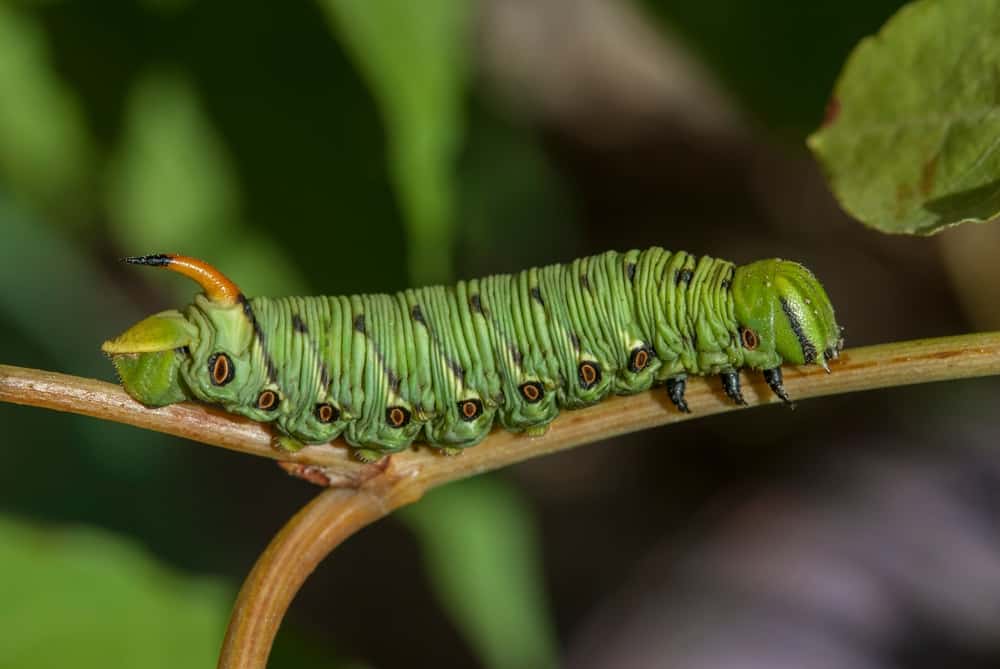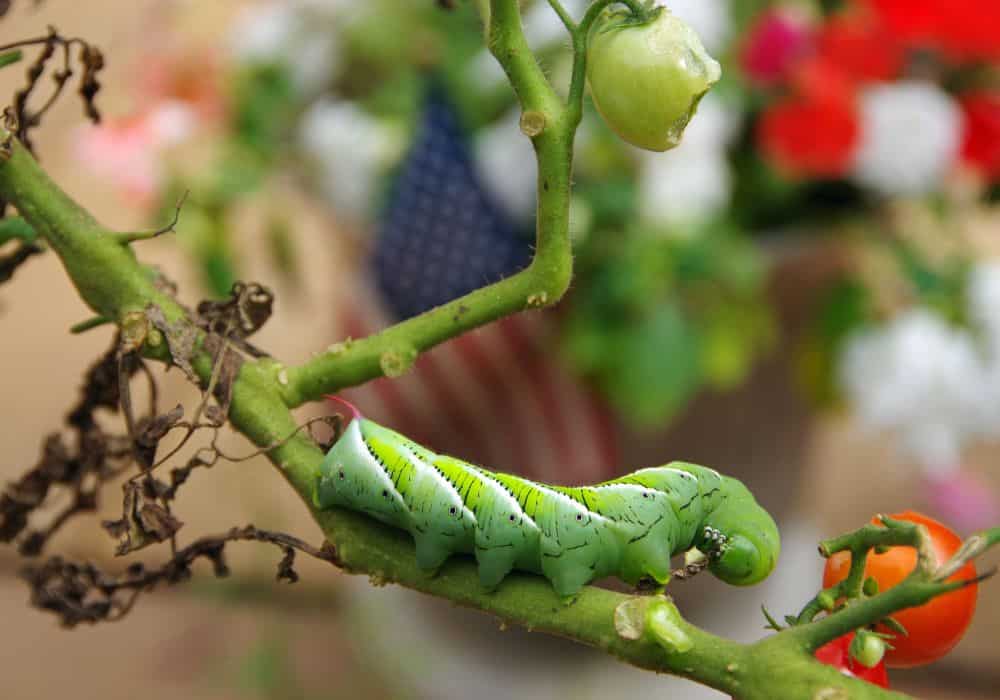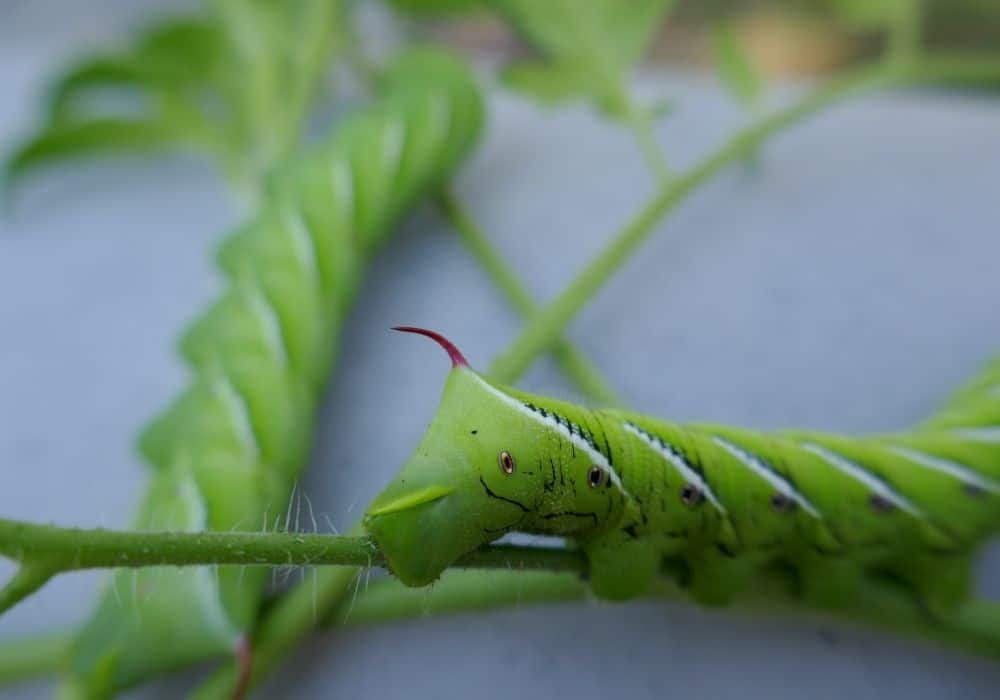Hornworms are one of many insects we incorrectly call “worms”. In reality, these interesting creatures are the caterpillars that later in their life turn into the large Sphinx moth. They have “worm” in their name largely because people back in the day didn’t care much about the difference between worms and caterpillars. As for the “horn” part, that’s due to their interesting appearance and the thin red “horn” coming out of their backside.
Now that we know what hornworms actually are, however, the next question is what do hornworms eat? Are they a pest in the wild? How should they feed them if they are a pet? Or, maybe you’re looking after them just as food for another pet of yours? Let’s go over each case one by one.
About Hornworms
As caterpillars for the rather large Sphinx moth, hornworms live in this stage of their way for no more than 2 to 3 weeks. They spend that time eating as much food as they possibly can before burying in the ground as pupae chrysalis. After that, they emerge as their true selves – the large adult Sphinx moth or hawk moths.
Despite the short time these insects spend in their hornworm phase, they can still cause a lot of damage to farmers’ crops. That’s why they are often seen as pests by many people. Alternatively, when looked after at home, they will need quite a bit of food to grow well and healthy.
On average, hornworms grow up to 4 inches long (~10 cm) and about 4 grams in weight. To achieve and maintain that physique, however, they need to eat 16 grams of food every day, whether they are in the wild or in captivity – that’s 4 times their body weight.
What Do Hornworms Eat in the Wild?
Hornworms are famous for loving two plants above all others – tomatoes and tobacco. These can sound like two very different and random dietary choices before you realize that these two plants are actually close relatives. Both tomatoes and tobacco are members of the Nightshade family of plants or vegetables.
The reason why hornworms go after nightshades so passionately in the wild is twofold:
- One, because the leaves of these plants have all the nutrients hornworms need to grow fast and healthy
- Two, because nightshades have certain chemicals that can make hornworms a bit toxic for predators, thus acting as a self-defense mechanism for these caterpillars. In fact, the sub-species of hornworms that gravitated toward tobacco also develop a sort of “bad breath” from the plant’s leaves which further helps them deter predators
The other members of the Nightshade plant family hornworms tend to go for include:
- Tomato leaves
- Green tomatoes
- Tobacco leaves
- Eggplant
- Red Bell peppers
- Mulberry tree leaves
- Horsenettle
- Jimsonweed
- Silver nightshade
- Potato
- And others
Not only do nightshades come in multiple different species but so do hornworms. This is important because different hornworms gravitate toward different nightshades even though tomatoes and tobacco are the main two favorites. For example, the tobacco hornworms of the Manduca sexta moth are notorious for loving tobacco while the tomato hornworms of the Manduca quinquemaculata moth prefer tomatoes.
Still, with over 120 hornworm species in North America and over 1,200 worldwide, it’s often difficult to know which type you’re dealing with.
So, the safest bet for farmers usually is to just assume all their nightshade plants are at risk if they start seeing large moths fly by or the hornworms themselves crawling around.
Are Hornworms Harmful?
Hornworms aren’t harmful to people but they can wreak quite a bit of havoc in a farmer’s fields. A single hornworm eats about 16 grams of leaves a day so that’s several hundred grams through its 2 to 3 weeks lifetime. That doesn’t sound like much but that’s basically a whole tomato plant ruined.
And when you consider that hornworm moth infestations usually include numerous moths and an incalculable number of moth eggs that hatch into hornworms – it’s not uncommon for entire fields of tobacco or tomatoes to get devastated in a matter of days.
In that sense – yes, hornworms are quite harmful. But it’s not all bad for two main reasons:
While hornworms are nasty when they latch onto the wrong plant, they can be repelled via several different methods, including natural ones. And if you’ve managed to repel the moths from laying their eggs directly under their produce, there’s no harm done if they do so somewhere outside of your property.
What’s more, the moths the hornworms turn into are actually beneficial both for the environment as a whole and for our crops. That’s because – just like butterflies and bees – moths act as pollinators. So, they are essential for the whole ecosystem and the well-being of all the flora in it.
How to Control and Prevent Hornworms
So, how can we prevent a hornworm infestation in the middle of our tomato field, preferably without losing the beneficial effect of the moths’ pollination? Well, there are a few proven methods to consider:
- Place some other plants you know hornworms avoid in between your tomatoes or other nightshade plants. The most prominent examples of such plants are basil, dill, and marigolds. If you have enough of any of those interspersed in between your nightshades, the Sphinx moths will be very likely to just avoid your nightshade garden altogether and pick a different spot to lay their eggs.
This is the most ideal approach in most cases as it ticks all the boxes: 1) it prevents the infestation, 2) it allows the moths to still exist and work as pollinators, 3) it involves no toxic insecticides, and 3) it gets some basil or dill in your garden as a bonus. - Do some tilling of the soil if you’ve noticed/suspected that moths have laid eggs there. Such tilling can solve the issue very quickly as it will kill the moths’ eggs before they’ve even hatched. However, soil tillage can increase the risk of soil erosion so it shouldn’t be done too often. Plus, that removes the benefits of having pollinating moths around.
- Apply some soapy water directly onto the nightshade plants you see have been infected. This is a quick and easy way to kill the hornworms themselves if they’ve already hatched, gotten out of the larvae state, and climbed on top of the plants. As long as the soap isn’t overly toxic, it should be safe for the plants and the soil too.
- Remove the hornworms by hand when you see them – they are perfectly harmless and can easily be crushed by hand. After that, you can toss them in a bucket of soapy water.
- You can also introduce some of the hornworm’s natural predators into its environment. A prime example is the Braconid wasps as they lay their own legs on top of the hornworms so that the wasps’ eggs and larvae can feed on the caterpillar and kill it in the process. If you don’t want swarms of wasps flying around your property, however, you can also look into introducing the much more harmless ladybugs or lacewings too – those also make short work of any hornworms they encounter and will also clean out other pests such as aphids.
How to Feed Hornworms in Captivity?
Now that we covered how to deal with hornworm pests in your garden, let’s look into raising these caterpillars at home yourself. If you don’t have nightshade plants to worry about, there’s no harm in looking after hornworms as you don’t have any crops for them to harm.
There are two main reasons why you’d look after hornworms at home:
- As an actual pet – many people like raising these caterpillars into moths and then releasing them into the wild. Not only is the transformation from a caterpillar into a chrysalis and into a moth fascinating but, as we said, the moths themselves are beneficial for the environment.
- Secondly, many people feed and raise caterpillars as food for their actual pets – usually for reptiles and amphibians such as geckos, bearded dragons, other lizards, or frogs. Hornworms make for excellent pet food because they are large, nutritious, and their exoskeleton is very soft and easy for reptiles and amphibians to chew through.
If you want to raise hornworms into moths just for the sake of it, you can just feed them their natural diet – tomato or tobacco leaves as well as other easily available nightshade plants.
There is a problem, however, if you’re raising your hornworms as pet food – if you feed your hornworms with nightshade, they will become poisonous and may harm your pets. As we said above, that’s one of the hornworm’s defense mechanisms. Some reptiles would be immune to that but many others aren’t.
In such cases, you’re going to have to look for a different hornworm chow such as broccoli, mashed celery, spinach, collard greens, dandelion leaves, mulberry leaves, or commercial paste pet food that usually includes ingredients such as wheat germ, agar, yeast, dandelion, linseed oil, grapevine leaves, and others.
Conclusion
Hornworms can either be an annoying pest to have to deal with, a fascinating pet to raise, or pet food to keep well fed for your amphibian or reptilian pets. In either of these three cases, it’s important to know exactly what hornworms eat and how to approach the particular situation in the best possible way.


